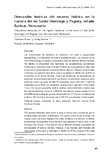| dc.rights.license | http://creativecommons.org/licenses/by-nc-sa/3.0/ve/ | |
| dc.contributor.author | Rivas Vergara, Francisco | |
| dc.contributor.author | Bracho Yorley | |
| dc.date.accessioned | 2015-09-22T15:19:05Z | |
| dc.date.available | 2015-09-22T15:19:05Z | |
| dc.date.issued | 2011-06 | |
| dc.identifier.issn | 0798-2437 | |
| dc.identifier.uri | http://www.saber.ula.ve/handle/123456789/40867 | |
| dc.description.abstract | Las estimaciones de demanda se realizaron con base a proyecciones demográficas y a dotaciones normativas predeterminadas. Las cuencas de los ríos Santo Domingo y Paguey se encuentran entre los estados Mérida y Barinas. Por Mérida se encuentran tres municipios de características montañosas: Pueblo Llano, Santo Domingo y Rangel. Por Barinas se encuentran en diferentes proporciones territoriales los municipios Bolívar, Barinas, Obispos, Cruz Paredes y Pedraza, la superficie total de la cuenca se estima en 4.923 km2, el 91% se encuentran en el estado Barinas. Según las tendencias de extrapolación de población, es el municipio Barinas el que mostró un crecimiento acelerado en su población urbana pasando de 249.776 habitantes para el año 2001 a 545.3314 habitantes para el 2036. Las demandas urbanas para el año 2012 varían desde 7,1/s y 12,2 l/s para pequeños centros urbanos como Santa Inés y Santa Lucía del municipio Barinas, hasta los 1.450,4 l/s para Barinas ciudad capital. Para el año 2036 las demandas de agua se ubican entre los 17,7 l/s para la población de la Mula y 26,2 de Santo Domingo y los 2.227,5 l/s para Barinas ciudad Capital. | es_VE |
| dc.language.iso | es | es_VE |
| dc.rights | info:eu-repo/semantics/openAccess | |
| dc.subject | Demandas de agua | es_VE |
| dc.subject | Población | es_VE |
| dc.subject | Dotación | es_VE |
| dc.subject | Cuenca Santo Domingo | es_VE |
| dc.subject | Barinas | es_VE |
| dc.title | Demandas teóricas del recurso hídrico en la cuenca del río Santo Domingo y Paguey, estado Barinas. Venezuela | es_VE |
| dc.title.alternative | Theoretical demands of the hydric resource in the basin of the Santo Domingo and Paguey river, Barinas state. Venezuela | es_VE |
| dc.type | info:eu-repo/semantics/article | |
| dc.description.abstract1 | The demand estimates were made in base to demographic projections and to predetermined normative endowments. The basins of the Santo Domingo and Paguey rivers are found between the states of Mérida and Barinas. In Mérida we find three municipalities of mountainous characteristics: Pueblo Llano, Santo Domingo and Rangel. In Barinas we find in different territorial proportions the municipalities of Bolívar, Barinas, Obispos, Cruz Paredes and Pedraza, the total surface of the basin is estimated in 4.923 km2, 91% is located in the state of Barinas. According to the of extrapolation of population tendencies, the municipality of Barinas showed an accelerated growth in its urban population going from 249.776 inhabitants for the year 2001 to 545.3314 inhabitants for the 2036. The urban demands for the year 2012 vary from 7,1/s and 12,2 l/s for small urban centres like Santa Inés and Santa Lucia municipality Barinas to 1.450,4 l/s for Barinas capital city. For the year 2036 the demands of water situate between the 17,7 l/s for the population of the Mula and 26,2 for Santo Domingo and the 2.227,5 l/s for Barinas Capital city. | es_VE |
| dc.description.colacion | 39-64 | es_VE |
| dc.description.email | vergara@ula.ve | es_VE |
| dc.description.frecuencia | semestral | |
| dc.identifier.depositolegal | 198102ME433 | |
| dc.publisher.pais | Venezuela | es_VE |
| dc.subject.facultad | Facultad de Ciencias Forestales y Ambientales | es_VE |
| dc.subject.institutoinvestigacion | Instituto Forestal LatinoAmericano (IFLA) | |
| dc.subject.keywords | Demands of water | es_VE |
| dc.subject.keywords | Population | es_VE |
| dc.subject.keywords | Endowment | es_VE |
| dc.subject.keywords | Santo Domingo basin | es_VE |
| dc.subject.keywords | Barinas | es_VE |
| dc.subject.publicacionelectronica | Revista Forestal Latinoamericana | |
| dc.subject.seccion | Revista Forestal Latinoamericana: Artículos | es_VE |
| dc.subject.thematiccategory | Geografía | es_VE |
| dc.subject.thematiccategory | Medio Ambiente | es_VE |
| dc.subject.tipo | Revistas | es_VE |
| dc.type.media | Texto | es_VE |


